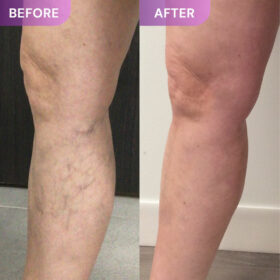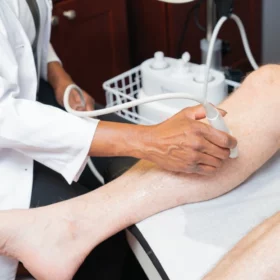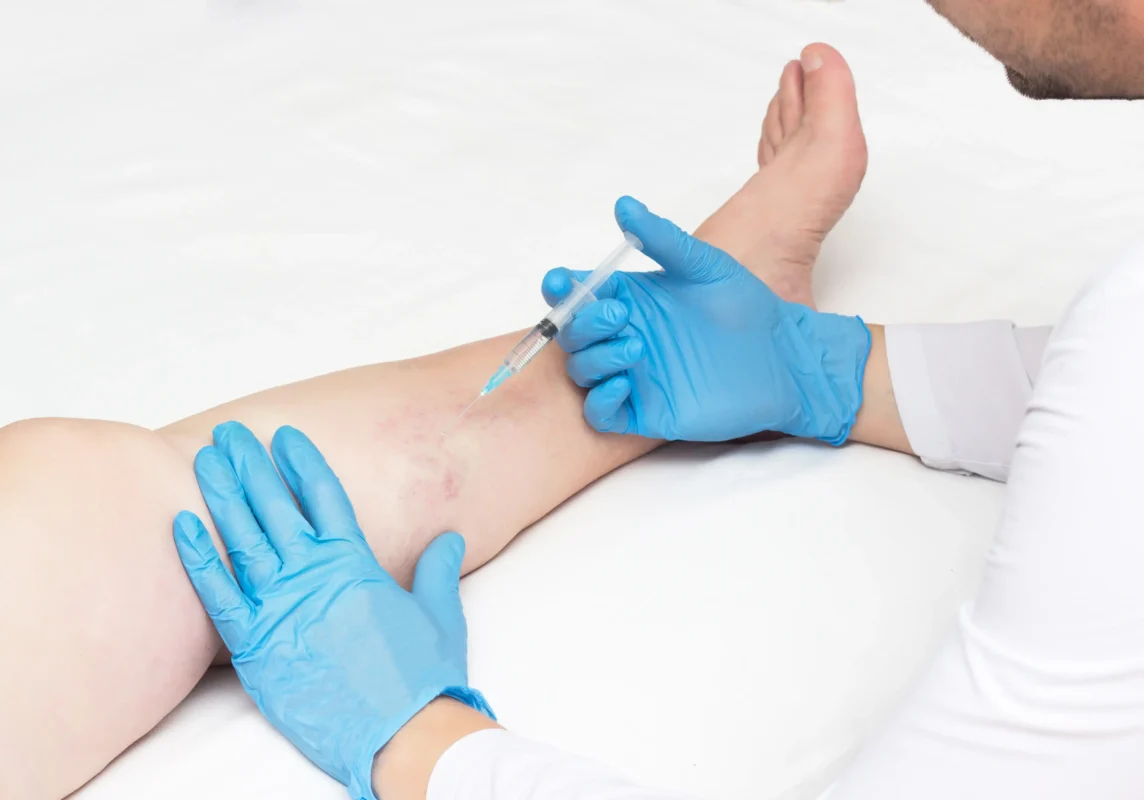At Vein Treatment Clinic, we’re always at the forefront of innovation, seeking out the latest advancements to provide our patients with the best care possible. One such groundbreaking technology that’s revolutionizing vein treatment and diagnosis is Artificial Intelligence (AI). In this guide, we’ll explore the role of AI in vein treatment and diagnosis, answering all your questions and shedding light on how this cutting-edge technology is transforming vein care.
What is AI, and How Does it Apply to Vein Treatment?
Artificial Intelligence, or AI, refers to the simulation of human intelligence processes by machines, especially computer systems. In the context of vein treatment, AI algorithms are used to analyze medical data, images, and patient information to assist in diagnosis, treatment planning, and even predicting outcomes. This enables us to harness vast amounts of data and derive valuable insights that aid in providing personalized care to our patients.
How Does AI Assist in Vein Diagnosis?
One of the most significant applications of AI in vein treatment is in diagnosis. AI algorithms can analyze various imaging modalities, such as ultrasound scans and venograms, to detect and classify different types of vein disorders with remarkable accuracy. By leveraging machine learning techniques, AI systems can identify patterns and anomalies in these images that may not be immediately apparent to the human eye. This not only speeds up the diagnostic process but also enhances its accuracy, leading to more precise treatment recommendations.
Can AI Predict Vein Conditions Before They Manifest?
Indeed, one of the most exciting aspects of AI in vein treatment is its potential to predict vein conditions before they become symptomatic. By analyzing patient data, including medical history, lifestyle factors, and genetic predispositions, AI algorithms can identify individuals who may be at higher risk of developing vein disorders in the future. This proactive approach allows us to intervene early, implementing preventative measures and lifestyle modifications to mitigate the risk of more severe vein problems down the line.
How Does AI Improve Vein Treatment Outcomes?
The integration of AI into vein treatment has been shown to improve treatment outcomes significantly. By leveraging AI algorithms to assist in diagnosis and treatment planning, vein specialists can make more informed decisions, leading to better patient outcomes and reduced complications. Additionally, AI-powered predictive analytics can help identify patients at higher risk of treatment failure or recurrence, allowing for proactive management strategies.
What are the Benefits of AI for Vein Treatment & Diagnosis?
- Enhanced Diagnostic Accuracy: AI algorithms can analyze medical imaging with incredible precision, detecting subtle abnormalities that may be overlooked by human observers.
- Personalized Treatment Plans: By analyzing patient data, AI can recommend treatment plans based on factors like medical history, lifestyle, and genetic predispositions.
- Early Detection and Prevention: AI can identify individuals at higher risk of developing vein disorders before symptoms arise, enabling early intervention and preventive measures.
- Improved Treatment Outcomes: AI assists vein specialists in treatment planning and helps optimize treatment strategies, leading to better outcomes and reduced complications.
- Streamlined Workflows: AI technologies streamline administrative processes, such as scheduling and documentation, allowing vein doctors to focus more on patient care.
- Research and Innovation: AI facilitates data analysis and research, driving innovation in vein treatment and contributing to the development of new therapies and techniques.
- Patient Empowerment: By providing patients with access to information and insights, AI empowers them to actively participate in their treatment decisions and self-care practices.
How Vein Treatment Clinic Remains Ahead of the Curve
At Vein Treatment Clinic, we pride ourselves on staying ahead of the curve in vein treatment and diagnosis. Through a combination of advanced technologies, innovative approaches, and patient-centered care, we provide our patients with the best possible outcomes.
State-of-the-Art Vascular Imaging Tests
Accurate diagnosis is the cornerstone of effective vein treatment. That’s why we utilize state-of-the-art vascular imaging tests to assess the health of our patients’ veins thoroughly. From ultrasound Doppler scans to venous duplex imaging, our advanced imaging modalities allow us to visualize blood flow, identify abnormalities, and pinpoint the root cause of vein problems with exceptional precision.
The following are the benefits of Duplex ultrasound tests:
- Accurate Diagnosis: Duplex ultrasound tests provide detailed images of the veins and arteries, allowing for precise diagnosis of various vascular conditions.
- Non-Invasive: Unlike traditional angiography, Duplex ultrasound tests are non-invasive, meaning they do not require incisions or injections of contrast dye.
- Real-Time Imaging: Duplex ultrasound provides real-time imaging of blood flow, enabling immediate assessment of vascular function and abnormalities.
- Versatility: Duplex ultrasound can be used to evaluate both superficial and deep veins, making it a versatile tool for diagnosing a wide range of vascular disorders.
- Guidance for Treatment Planning: Duplex ultrasound provides detailed anatomical information, helping vein specialists determine the most appropriate course of action.
- Monitoring Treatment Progress: After vein treatment procedures, Duplex ultrasound can be used to monitor treatment success and detect any signs of recurrence or complications.
Diagnosing the Root Cause of Vein Problems
Many vein disorders, such as varicose veins and spider veins, stem from an underlying condition known as Chronic Venous Insufficiency (CVI). At Vein Treatment Clinic, we specialize in diagnosing and treating CVI, addressing the underlying cause of our patients’ vein problems rather than just the symptoms. Through comprehensive evaluations and diagnostic tests, we accurately identify CVI and tailor our treatment approach to each patient’s unique needs.
Minimally Invasive Vein Treatments
Gone are the days when vein treatment required invasive surgery and lengthy recovery times. At Vein Treatment Clinic, we offer a wide range of minimally invasive vein treatments that deliver excellent results with minimal discomfort and downtime. From endovenous laser therapy (EVLT) to sclerotherapy and radiofrequency ablation (RFA), our advanced procedures target diseased veins directly, sealing them shut and rerouting blood flow to healthier veins.
The following are the benefits of minimally invasive vein treatments over vascular surgery:
- Less Invasive: Minimally invasive vein treatments involve small incisions or injections, compared to the larger incisions required for surgery, resulting in less trauma to the body.
- Faster Recovery: Minimally invasive procedures typically have shorter recovery times than vascular surgery, allowing patients to return to their normal activities sooner.
- Reduced Risk of Complications: Minimally invasive treatments carry a lower risk of complications such as infection, bleeding, and nerve damage.
- Local Anesthesia: Minimally invasive procedures are often performed under local anesthesia, reducing the need for general anesthesia and its associated risks.
- Outpatient Setting: minimally invasive vein treatments can be performed on an outpatient basis, eliminating the need for hospitalization and reducing healthcare costs.
- Minimal Scarring: Minimally invasive procedures result in smaller scars or no visible scarring at all compared to the larger scars often associated with vascular surgery.
- Preservation of Surrounding Tissues: Minimally invasive treatments target diseased veins directly, preserving surrounding healthy tissue and minimizing collateral damage.
- Comparable Efficacy: Minimally invasive vein treatments have been shown to be as effective as vascular surgery in treating vein disorders, with comparable long-term outcomes.
Avoiding Surgery Whenever Possible
Surgery is a last resort in vein treatment, reserved for severe cases that don’t respond to conservative measures. At Vein Treatment Clinic, we prioritize non-surgical interventions whenever possible, opting for minimally invasive procedures that offer comparable efficacy with fewer risks and complications. By avoiding surgery, we minimize trauma to the body and expedite our patients’ recovery, allowing them to return to their normal activities sooner.
Lifestyle Recommendations to Mitigate Risks
We emphasize the importance of lifestyle modifications in managing vein disorders and reducing the risk of recurrence. Our vein specialists provide recommendations tailored to each patient’s needs, including tips for maintaining a healthy weight, staying active, elevating the legs, wearing compression stockings, and avoiding prolonged periods of sitting or standing.
You can implement these lifestyle changes to reduce the risk of vein disease:
- Maintain a Healthy Weight: Excess weight can put added pressure on veins, increasing the risk of vein disorders. Aim for a healthy BMI through diet and exercise.
- Stay Active: Regular physical activity promotes healthy circulation and helps prevent blood from pooling in the legs. Incorporate activities like walking, swimming, or cycling into your routine.
- Elevate Legs: Elevating your legs above heart level when resting helps reduce swelling and improves blood flow back to the heart.
- Wear Compression Stockings: Compression stockings apply pressure to the legs, aiding in circulation and reducing the risk of varicose veins and swelling.
- Avoid Prolonged Sitting or Standing: Take breaks to move around if you have a sedentary job, and avoid standing or sitting for long periods without breaks.
- Stay Hydrated: Drinking plenty of water helps maintain blood volume and prevents dehydration, which can exacerbate vein problems.
- Follow a Balanced Diet: Incorporate foods rich in fiber, vitamins, and antioxidants to support cardiovascular health and prevent inflammation.
- Quit Smoking: Smoking damages blood vessels and impairs circulation, increasing the risk of vein disorders. Quitting smoking can improve vascular health.
- Manage Stress: Chronic stress can contribute to high blood pressure and poor circulation. Practice stress-reducing techniques such as mindfulness, meditation, or yoga.
- Check Family History: If you have a family history of vein disorders, be proactive about monitoring your vascular health and seek medical advice if needed.
Schedule Your Consultation for Comprehensive Vein Care
At Vein Treatment Clinic, we’re dedicated to offering comprehensive vein care that addresses the root causes of vein problems and empowers our patients to live healthier, more active lives. By combining advanced technologies, minimally invasive procedures, and personalized lifestyle recommendations, we remain at the forefront of vein treatment. We have offices across the United States, including New York, New Jersey, Maryland, and California — please schedule an appointment at your nearest vein treatment clinic for advanced vein care.












